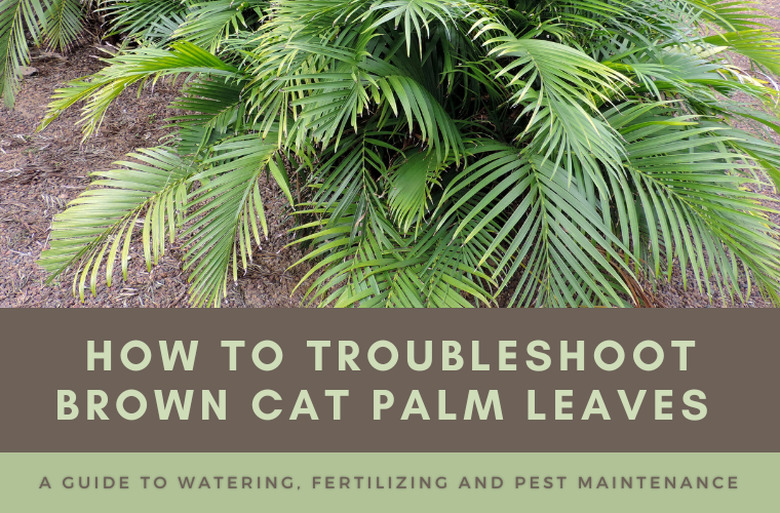How To Troubleshoot Cat Palm Leaves That Are Turning Brown
The cat palm (Chamaedorea cataractarum) is one of several species of slow-growing palm trees known as parlor palms that are typically grown indoors as houseplants. A stemless palm, the cat palm is considered an easy indoor palm to care for.
Nonetheless, a few factors can result in cat palm dead leaves and cat palm brown spots, including cold temperatures, a lack of moisture or too much fertilizer. The extent, characteristics and location of the browning can help you determine and rectify the cause.
Cat Palm Brown Spots
Cat palms should be fertilized just two or three times a year during the growing season with a slow-release fertilizer formulated for palms, says the Clemson Cooperative Extension. If you notice the tips of your cat palm's lower leaves turning brown, excessive fertilization could be to blame. In addition, too much iron can cause spots on the leaves of indoor palms.
Parlor palms such as the cat palm also require winter temperatures around 60°F. Brownish patches on the leaves of a cat palm can be the result of several days of exposure to temperatures below 45°F.
The University of Maryland Extension also notes that indoor palm leaves that collect dust on the foliage may absorb less light. This can result in a yellowing of the leaves, known as chlorosis. It is therefore a good idea to wipe down your cat palm's leaves regularly.
Cat Palm Watering
All indoor palms, including cat palms, need consistent moisture. It is important that the growing medium never dry out completely. A lack of water can result in brown spots on leaves, or entire leaves drying out and falling off the plant. Too much water, however, can also lead to root rot, which can be fatal, so it is important that the soil drains well.
Air humidity is also key to avoiding browning of cat palm leaves. Leaves may dry out if humidity is below 50 percent. Using a humidifier is one way to address this problem, according to the Clemson Cooperative Extension. You can also opt to mist the plant with water once a week.
Pests of Cat Palms
While cat palm diseases are rarely a concern, like other houseplants, cat palms can be affected by a number of pests. The feeding of these pests can affect the appearance of the leaves.
Spider Mites
For example, spider mites, which are almost imperceptible to the naked eye, can cause speckling on the upper sides of leaves. In severe cases, the leaves may turn brown and fall off. If your cat palm is infested with spider mites, you may notice the webbing they create between fronds.
Scales and Mealybugs
Other pests, known as scales and mealybugs, also feed on plant sap and can lead to discoloration on the leaves. Scales and spider mites can be dislodged from the cat palm leaves using a stream of water. If an indoor plant becomes heavily infested, it may be best to discard it.
Moving indoor palms outdoors during the summer months exposes the plant to outdoor predators and can help prevent significant pest infestations from developing.
